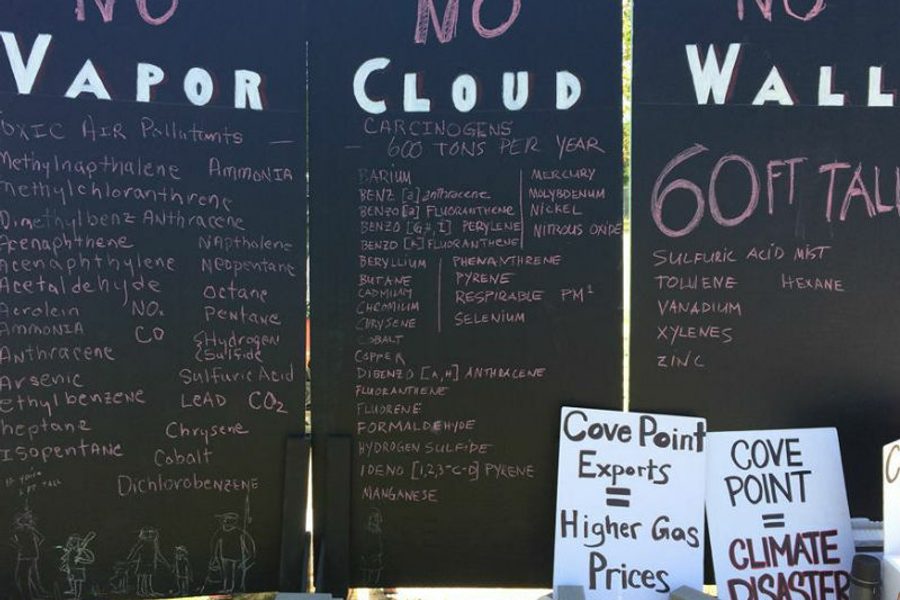Monkey Wrenching the Frackers
Radical environmentalists prepare to fight gas export terminal through direct action.
Cole Stangler

“All right, motherfuckers! This is an unlawful assembly!”
A group of five “police” charge at a mob of milling “protesters,” throwing several to the ground and playfully beating them with rolled-up pieces of old newspaper — the “batons.” “Fucking hippies!” someone shouts from the tussle.
The make-believe cops have been supplied with blaze orange construction vests, plastic badges and faux police caps, which combine with their many tattoos and piercings to make them look like a punk version of the Village People.
This mock police ambush was part of a three-hour crash course in “Responsible Direct Action” held at last week’s Energy Exports Action Camp in Maryland’s Jug Bay Natural Area, a county park some 25 miles southeast of Washington, D.C. The week-long camp was designed to train, connect and energize activists gearing up to take direct action to stop Dominion Energy’s Cove Point project, a natural gas export terminal planned in Lusby, Md. Opponents say the plant will encourage more fracking, spur Maryland to drop its state-wide moratorium on the practice, and exacerbate global climate change.
The camp’s core organizers hail from Chesapeake Earth First!, a local chapter of the loosely organized national environmental group. They were joined by about 60 activists from around the mid-Atlantic region, including other Earth Firsters and non-aligned sympathizers. In keeping with their infamous slogan, “No Compromise in the Defense of Mother Earth,” Earth Firsters support what’s known as a “diversity of tactics” — code for a willingness to use force. Historically, their bag of tricks has included blockades, tree-sits, and in rare cases, acts of industrial sabotage, or “monkey-wrenching,” a term popularized by Edward Abbey’s classic 1975 novel.
Activists at the camp are encouraged to use “every tool in the toolbox,” according to Richelle Brown, one of the organizers, “from lawsuits to lock-downs.”
As Earth First! and its rabble-rousing sympathizers prepare to jump into the fray, they open a new chapter in the struggle to stop Cove Point. To date, protests against Cove Point, led mostly by the non-profit Chesapeake Climate Action Network (CCAN), have included a large rally in Baltimore, smaller rallies at the offices of elected officials, and a couple of civil disobedience actions at two different county courthouses — none of which has managed to seriously disturb Dominion’s dreams of becoming the first gas exporter on the East Coast. It’s hard to say what direct actions Earth First! is planning, since activists traditionally keep mum on any such plans. Nobody I asked told me of any specific plots. But Batty, a Baltimore-based activist who declined to provide her full name, says, “The protests have been very fluffy. As we say, things need to get a bit spikier. Because spikier gets more attention.”
The consequences of Cove Point
After fracking and horizontal drilling took off in 2008, domestic prices of natural gas fell steeply. Aroused by the allure of new markets, U.S. gas producers are increasingly looking to take their goods abroad: most notably to Asia, where liquefied natural gas (LNG) fetches about triple its price stateside. In 2011, Dominion Energy started making moves to convert Cove Point—a seldom-used LNG import facility built in the 1970s to service gas from Algeria—into an export facility.
Unlike, say, TransCanada’s Keystone XL pipeline, which is still awaiting State Department approval, Cove Point is breezing through the federal regulatory process for LNG export terminals. The Department of Energy (DOE) has already granted conditional approval — the first big step in the permitting process. Now, the Federal Energy Regulatory Commission (FERC) appears to be on the verge of giving the thumbs up — the second major hurdle before construction can move forward. The other key permit-issuing agencies in this case, such as the Army Corps of Engineers and Environmental Protection Agency (EPA), have until mid-August to weigh in. Meanwhile, a separate 30-day public comment period for the assessment ends June 16. By law, FERC needs only to wait for that public comment period to conclude before making a decision. But a negative response from one of the key permit-issuing agencies — the EPA, for instance — could cause further delays.
An agency spokesperson tells In These Times that FERC will take the time to carefully review the public comments before coming to judgment. But the radicals at Jug Bay have little faith FERC will reverse course.
“They are essentially a rubber-stamp for industry,” says Jesse Schultz, a Chesapeake Earth Firster and Industrial Workers of the World member who biked to the action camp from his house in D.C..
Among the crew’s many gripes with the agency is its unwillingness to acknowledge Cove Point’s full climate-change impact. Critics say that an environmental assessment issued last month by FERC glossed over the full cycle of greenhouse gas emissions associated with the terminal — that is, the cumulative methane and carbon emissions produced by drilling, transporting, liquefying, re-converting and shipping natural gas across the globe.
Another major grievance is FERC’s rejection of environmental advocates’ claims that Cove Point could lead to more fracking in the region — arguably, the single greatest rallying point for the opposition. “The specific details, including the timing, location, and number of additional production wells that may or may not be drilled, are speculative,” FERC’s assessment reads. “As such, impacts associated with the production of natural gas that may be sourced from various locations and methods for export by the Project are not reasonably foreseeable or quantifiable.”
Kelly Canavan, one of the camp’s organizers, says the agency’s claims are especially frustrating because publicly available information shows otherwise. Last December, Cabot Oil & Gas signed a 20-year agreement to supply Cove Point with gas from the Marcellus Shale. The deal supplies almost half of the terminal’s capacity. Transco’s proposed expansion of the Atlantic Sunrise pipeline will ensure that Pennsylvania-drilled gas flows to the terminal. Critics say that new infrastructure will help sustain affordable fracking in the region for the long run.
What is to be done?
On July 13, Chesapeake Climate Action Network (CCAN) — an environmental non-profit that has galvanized in-state opposition — will hold a mass protest march in Washington, D.C., calling on FERC to reject the project. The march comes on the heels of a February rally in Baltimore, deemed the largest environmental protest in city history.
But action camp participants believe that it’s going to take more than continued marches and appeals to public officials to put the brakes on Cove Point.
Environmentalist activism against the project and local advertising in its favor by Dominion have faced off to influence public opinion. But when it comes to the key regulators and politicians, the CCAN-led coalition of non-profits has struggled to land its punches. For months now, CCAN has unsuccessfully demanded that FERC conduct an environmental impact statement (EIS) rather than the less thorough environmental assessment. FERC maintains an EIS is unnecessary since Cove Point already exists as an import facility and would not be built from scratch.
CCAN has also fruitlessly called on Maryland’s two U.S. Senators, Democrats Ben Cardin and Barbara Mikulski, to demand an EIS. Meanwhile, on May 30, the Maryland Public Service Commission approved Dominion’s proposal to build a power generating station for Cove Point—in defiance of a CCAN-driven April petition delivery of more than 35,000 signatures against the plan as a whole.
So what’s it going to take?
Kelly Canavan, who also heads the Accokeek Mattawoman Piscataway Creeks Council, a local non-profit, says the key is delaying construction until it’s no longer profitable for Dominion to continue.
For one, that includes “paper-wrenching” — lawsuits that force Dominion to expend its team of highly paid corporate lawyers and experts to stamp out an array of legal challenges. Canavan pointed to two such lawsuits filed on behalf of the AMP Creeks Council: One alleges the Calvert County’s Board of Commissioners improperly used zoning text amendments to pave the way for Cove Point and another targets the County’s non-disclosure agreement with Dominion.
Canavan also says the AMP Creeks Council will appeal the appeal the Public Service Commissions’ recent approval of the power station.
“We are absolutely in it to win every one of these fights,” she stresses.
Then there’s the direct action route: Unpredictable headline-generating actions at various pieces of Cove Point-related infrastructure could force Dominion to spend more money on public relations, beef up its security presence, and encourage more public scrutiny of the project.
“Part of the project’s success hinges on sticking to a timeline; [Dominion] has said that publicly several times,” Canavan says. “So every time we appeal something, every time we drag out a lawsuit, every time someone steps in and does some sort of direct action, it throws them off their timeline.”
Canavan even hinted at some potential targets.
“Dominion is starting to move forward with preliminary steps like clearing off ‘Site A’ [a parking and storage space a mile and a half away from the main site] and starting construction of their pier,” she says. “I fully expect to see autonomous direct action begin to take place.”
“What I would like to see?” asks Batty. “Maybe something a bit creative and a little bit cheeky — you can do [those actions] in a way that makes people feel really great, and those are always the most powerful.”
The gang
Of the 60 or so camp attendees, only a handful actually reside in Calvert County. Most travelled to Jug Bay from D.C., Baltimore and Philadelphia. Many had already met each other at similar action-oriented camps: Shalefield Justice Spring Break in central Pennsylvania, which focused on fracking, or Mountain Justice Spring Break, based this year in northern West Virginia, and geared toward the coal industry.
The roving band of mostly 20-somethings is driven by an intense love for the eco-system, an equal measure of hatred for extractive industries and a deep mistrust in state-led responses to the climate crisis.
Earth Firsters and their allies tend to practice an intense form of “security culture” — a set of organizing principles designed to minimize the risk of information leaks to hostile parties. While activists may all consider themselves part of the same cause, they often work in individual affinity groups, i.e. “cells,” that don’t share information with each other.
Keeping from being publicly identified was a major concern for some.. At one point, I was reprimanded by a few activists for taking photos of the mock direct action that Nadine Bloch facilitated (despite identifying myself as a journalist, warning that I planned to take photographs, and getting approval from Bloch) Some of the participants accused me of violating their consent and insisted that I delete every photo I took. When I photographed a different session, a handful of people moved in order to get out of the shot.
This struck me as a bit paranoid, but it’s not without basis. In Green Is The New Red, a book recommended to me by several different Jug Bay campers, journalist Will Potter chronicles the U.S. government’s post-9/11 crackdown on radical environmentalists and animal rights advocates. The period is often known as the “Green Scare.”
The Bush administration may be gone, but the federal government still has an unfortunate tendency to treat peaceful environmental activists like violent terrorists. Sometimes this takes the form of draconian charges: Last December, for example, anti-Keystone XL activists were charged with staging a “terrorism hoax” after unfurling a banner at the Oklahoma City headquarters of Devon Energy.
Oftentimes, it’s just surveillance: This February, the Columbus Free Press obtained a July 2013 report from an FBI-Pennsylvania State Police Joint Terrorism Task Force focused on “eco-terrorism.” The report mentioned Marcellus Shale Earth First, warning that Pennsylvania and New York Earth First chapters were engaged in “active training events related to civil disobedience.”
But it’s part of the game, says Gabriel Echeverri, an ethnobotany major at Frostburg State University. “If you fight these kinds of things, if you fight these corporations, if you fight these governments, and your movement has any teeth to it, they come after you,” he says.
And there’s no doubt it’s worth it, he says.
“It’s necessary to fight to be able to look myself in the eye, to be able to have any kind of interaction with this natural world that I consider to be home, to be able to hold my head high when I walk through the woods and interact with the rest of our brothers and sisters in creation. To be able to do that, I have to do this. I have to fight,” Echeverri continues. “And maybe there is a certain amount of self-satisfaction that comes from throwing a wrench in the gears. From just screwing with them.”








